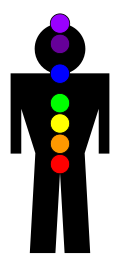Color therapy
| Against allopathy Alternative medicine |
| Clinically unproven |
| Woo-meisters |
Color therapy or chromotherapy (the favored term, as it seems less transparently stupid) is the pseudoscientific belief that shining different colored lights on a patient can cure any number of diseases by balancing "energy" (the special woo version) wherever a person is lacking it. Items which may be used in this therapy include lights with colored lenses, prisms, gemstones, or the wearing of colored eyeglasses.
It has been touted for the usual range of diseases from arthritis, asthma, anemia, and bronchitis to cancer. No scientific studies support its use in treating any of these conditions.
History[edit]
Color therapy as we know it was first described by Avicenna, who was writing in the early 1000s, so at least he had an excuse.
American Civil War General Augustus Pleasonton published The Influence Of The Blue Ray Of The Sunlight And Of The Blue Color Of The Sky in 1876 about how the color blue was simply marvelous. This was the birth of modern color therapy as we know it, nurtured in the hothouse of Victorian pseudoscientific mysticism.
Ayurvedic medicine also has a bit about colors, which was then backported and thoroughly assimilated into the modern manifestation.
One proponent of color therapy was Stanley Burroughs, who was also known for promoting the Lemonade Diet.
Theory[edit]
The basis of current color therapy is the belief that different colored lights correspond to chakras in the body, or to different organs in the body, which is an unscientific belief rooted in mysticism.
It's worked for centuries, honest. Also, it might be a bit quantumy.[1] There's hardly enough theory in it even to call it decently pseudoscientific.
Science[edit]
There's not a lot of scientific basis for this, amazingly enough. The closest is that psychology notes common effects of color on mood, though these are heavily culture-specific, and quite temporary.
The equivalent in real medicine is light therapy, where a full-spectrum lamp is used to treat skin conditions or seasonal affective disorder by mimicking the sun.[Note 1] The equivalent in real science is photobiology.
Color therapy is also an important aspect of patient care in hospitals and doctors' offices, as studies have come out showing correlations between colors in the rooms (as well as colors worn by nurses and doctors) and a patient's mood. Color therapy in this context is especially critical in long-term care situations, nursing homes, and of course, hospice care.[citation needed]
See also[edit]
Notes[edit]
- ↑ Protip: replace the sickly yellow compact fluorescent lamps in your house with daylight spectrum bulbs. Everything seems so much nicer.
References[edit]
- ↑ Samina T. Yousuf Azeemi and S. Mohsin Raza. "A Critical Analysis of Chromotherapy and Its Scientific Evolution". Evid Based Complement Alternat Med. 2005 December; 2(4): 481–488. doi: 10.1093/ecam/neh137 PMID PMC1297510. If that's a "critical" evaluation, I'd hate to see an "enthusiastic" one.


